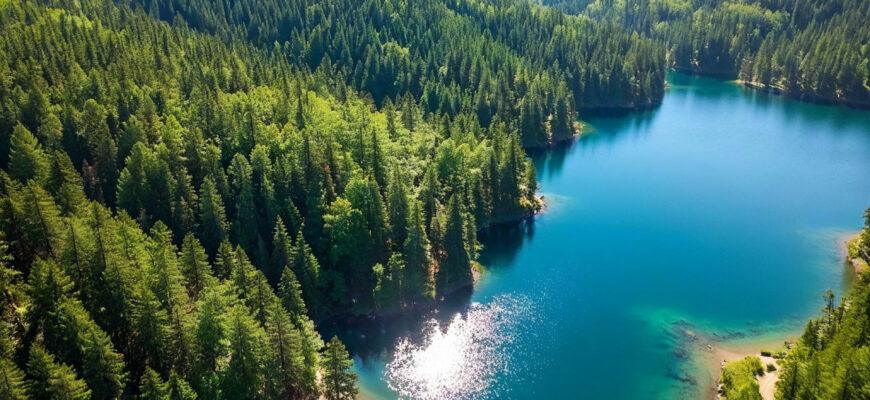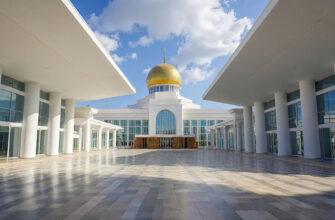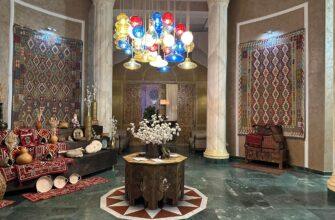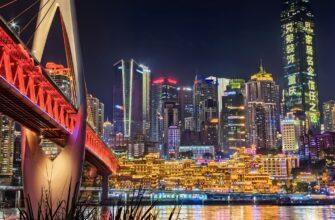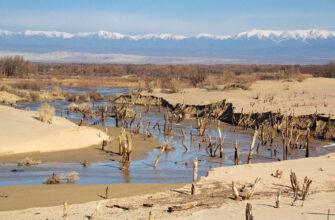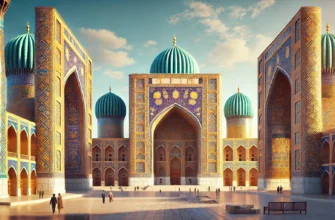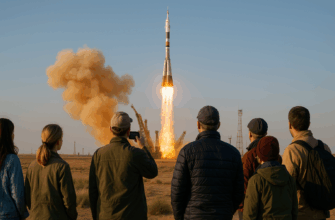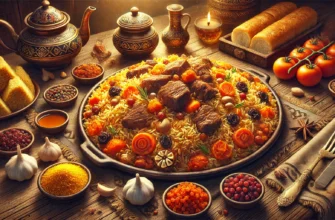The Natural and Cultural Landscape Surrounding Lake Burabai: Kazakhstan’s Pearl
Lake Burabai stands as one of Kazakhstan’s most precious natural treasures, surrounded by a diverse and captivating landscape that draws visitors from across the country and beyond. Often referred to as the “Pearl of Kazakhstan” or the “Kazakh Switzerland,” this remarkable ecosystem combines crystal-clear waters, majestic mountains, lush forests, and unique geological formations to create an environment of extraordinary beauty and ecological significance.
Geographic Setting of Lake Burabai
Location and Physical Characteristics

Lake Burabai (also known as Lake Borovoe or Borovoye) is situated in the Akmola Region of northern Kazakhstan, near the city of Kokshetau, within the eastern part of the Kokshetau Hills. The lake itself is relatively modest in size yet impressive in beauty, with a length of approximately 4.5 km (2.8 mi), a width of 3.9 km (2.4 mi), and a surface area of 11 km² (4.2 sq mi). The shoreline extends for 13.6 km (8.5 mi), offering varied landscapes from sandy beaches to rocky outcrops.
The lake reaches a maximum depth of 7 meters (23 ft) with an average depth of 3.4 meters (11 ft). Its waters are remarkably clear, allowing visitors to see the flat bottom in many areas. The water contains a slight salinity of 0.1-0.15%, contributing to its alleged healing properties.
Climate and Seasons
The climate surrounding Lake Burabai is extremely continental, characterized by hot summers and severe winters. This creates distinct seasonal experiences for visitors, with each season offering its own unique charm. Summer brings warm temperatures ideal for swimming and water activities, while winter transforms the landscape into a snow-covered wonderland perfect for winter sports and serene exploration.
The Kokshetau Mountains

The Kokshetau mountain massif forms a dramatic backdrop to Lake Burabai, with the highest point being Mount Sinyukha (also called Kokshe) reaching 947 meters above sea level. Other significant elevations include Mount Sedlovatka (Zheke Batyr) at 838 meters. These mountains are part of the northern outskirts of the Central Kazakhstan melkosopochnik, creating a stunning visual contrast to the steppe landscapes that surround the region.
The Natural Ecosystem
Forests and Flora

One of the most distinctive features surrounding Lake Burabai is its lush pine forests, which give the lake its Russian name “Borovoe” (derived from “bor,” meaning pine forest). These forests represent an extrazonal phenomenon in the region, standing in stark contrast to the surrounding steppe landscapes.
The Burabay area hosts approximately 800 plant species, creating a rich botanical environment. The flora includes 91 rare or relict plant species that require special protection, including 11 species listed in the Red Book of Plants of Kazakhstan. The area also contains 81 relict species that represent the boreal flora of the northern taiga, which find themselves at the southern boundary of their natural range in this region.
Wildlife and Fauna
The diverse ecosystems surrounding Lake Burabai support approximately 305 vertebrate animal species. This rich fauna contributes to the area’s designation as a biosphere reserve and national park. Wildlife observation opportunities abound for visitors who venture into the forests and mountains surrounding the lake.
The Lake’s Water Properties
The waters of Lake Burabai are not only visually stunning but are also known for their therapeutic qualities. Local traditions hold that the slightly saline water (0.1-0.15%) possesses healing properties. The lake is fed primarily by the River Sary Bulak and the Imanaevskii Stream, with outflow occurring through the River Kurkureuk.
Neighboring Lakes and Waterways
Lake Ulken Shabakty
To the north of Lake Burabai lies Lake Ulken Shabakty, separated only by a narrow strip of land. This proximity creates opportunities for visitors to explore multiple lake environments during a single visit to the region.
Lake Shchuchye
Located approximately 12 km (7.5 mi) to the southwest of Lake Burabai, Lake Shchuchye is the deepest lake in the region, reaching a depth of 23 meters. Its name comes from the Russian word for pike (shchuka), reflecting the lake’s popularity for fishing this species. From an aerial view, the lake resembles a dinosaur or seahorse, though this distinctive shape has gradually faded due to silting over time.
Other Lakes in the Burabay National Park
The Burabay National Park encompasses 14 lakes, each with a surface area exceeding 1 square kilometer, along with numerous smaller bodies of water. Notable among these are the Bolshoye and Maloye Chebache lakes (meaning “Big Chebache” and “Small Chebache”). Bolshoye Chebache is surrounded by mountains and benefits from a unique microclimate, while Maloye Chebache, though less frequented by tourists, offers spectacular views and a more secluded experience.
Geological Wonders
Unique Rock Formations
The landscape surrounding Lake Burabai features remarkable rock formations that have been sculpted by natural forces over millennia. Many of these formations resemble distinctive shapes, from Egyptian pyramids to various animals. These granite formations add a dramatic element to the already impressive landscape.
Zhumbaktas Island and Blue Bay

Near the northwestern cape of Lake Burabai stands the mushroom-shaped island of Zhumbaktas (meaning “Riddle-stone” or “Sphinx”). This rocky formation rises 20 meters (66 ft) above the water’s surface and resembles a sphinx with severe, fearless features. Nearby, the picturesque Blue Bay offers one of the most breathtaking views of the lake.
Okzhetpes Cliff and Other Landmarks
Among the most famous geological features is Okzhetpes cliff, whose name means “Inaccessible even to Arrows”. The peak of this formation resembles an elephant calf, adding to the mystical quality of the landscape. The Abylai Khan Valley, named after a prominent Kazakh khan, is another significant landmark that carries historical and cultural importance for visitors.
Human Elements and Infrastructure
Burabay Township and Settlements
The eastern shore of Lake Burabai hosts the Burabay spa town, which serves as the primary settlement and service center for visitors to the lake. This area provides accommodation, dining options, and various amenities for tourists throughout the year.
Recreation Facilities and Resorts
The Burabay National Park territory encompasses 35 permanent recreation facilities, offering a range of accommodation options from luxury resorts to more modest lodgings. The eastern shore features paid beaches with amenities such as sun loungers, cafes, water slides, swimming pools, and boat rentals. These facilities cater to the diverse needs of visitors seeking relaxation, adventure, or health improvement.
The Nature Museum and Cultural Sites
The eastern shore is also home to the Nature Museum (Табиғат мұражайы), where visitors can learn about the ecological and geological history of the region. This educational facility helps visitors appreciate the unique environment they are experiencing and understand conservation efforts in the area.
Recreational Opportunities
Summer Activities
During the warmer months, Lake Burabai transforms into a hub for outdoor recreation. Visitors can enjoy swimming in the crystal-clear waters, sunbathing on sandy beaches, boating, and various water sports. The surrounding forests and mountains offer excellent hiking and cycling opportunities, with trails leading to panoramic viewpoints overlooking the lake and surrounding landscapes.
One popular hike is to Mount Bolektau, which takes approximately 30 minutes and offers views of both Lake Burabai and Lake Bolshoye Chebachye. This relatively easy trail makes the spectacular vistas accessible to visitors of varying fitness levels.
Winter Experiences
Though visitor numbers decrease during the colder months, winter brings its own magic to Lake Burabai. The frozen lake allows people to walk across the ice to Zhumbaktas Rock, creating unique photographic opportunities. Winter sports enthusiasts can enjoy skiing and snowboarding in the surrounding hills, while the snow-covered forests provide a serene backdrop for nature walks.
Health and Wellness Tourism
The region has a long tradition as a health destination, with many visitors coming specifically for the therapeutic properties of the lake water and the oxygen-rich pine forest air. Spas and wellness centers in the area offer treatments that incorporate local natural elements, contributing to the region’s reputation as a place of healing and rejuvenation.
Cultural Significance and Legends
The Origin of the Name “Burabay”
According to local legend, a proud white camel named Bura once lived in the surrounding forests, protecting local inhabitants by warning them of dangers. After being wounded by a hunter, Bura sensed his approaching death and made his way to the lake, where he transformed into a great mountain. The area has been called Burabay ever since, with one of the peaks resembling the silhouette of a camel, complete with an arrow-shaped feature commemorating his sacrifice.
Local Folklore and Myths
Nearly every rock and geographical feature in the Burabay area has its own associated legend. These stories reflect the history and cultural identity of the Kazakh people, connecting the natural landscape to traditional narratives that have been passed down through generations.
Historical Significance
The historical name of the lake, Auliekol, means “holy lake,” indicating its spiritual significance to local populations throughout history. The lake has served as an important cultural and recreational resource for centuries, attracting visitors seeking both physical and spiritual renewal.
Conclusion
Lake Burabai and its surroundings represent one of Kazakhstan’s most precious natural environments, combining unique geological features, rich biodiversity, and cultural significance. The harmonious blend of mountains, forests, and crystalline waters creates a landscape of exceptional beauty that deserves its reputation as the “Pearl of Kazakhstan.” Whether visited for recreation, health benefits, or to experience its natural wonders, the region surrounding Lake Burabai offers a distinctive experience that showcases the natural splendor of northern Kazakhstan.
From the majestic Kokshetau Mountains to the mysterious rock formations, from the healing waters to the oxygen-rich forests, the diverse elements surrounding Lake Burabai come together to create an environment of extraordinary appeal that continues to enchant visitors from Kazakhstan and around the world.

